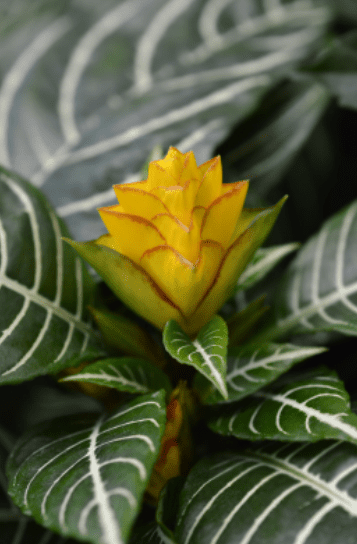
Zebra Plant Indoors
There are few plants as stunning and handsome looking like a zebra plant. Its distinct stripes set it apart from all other houseplants.
Aphelandra squarrosa is known as the zebra plant because of the bold ivory white veins on the bright green leaves.
It comes from Brazil, grows 30 cm (1ft) tall in a pot, and produces prominent spikes of yellow bracts in summer.
Seldom seen is a plant so brilliantly adorned. Its flower, too is totally unique and shaped like a perfect square. Hence the name aphelandra squarosa.
It has beautiful yellow bloom bracts, pyramid-shaped. The blooms spring from the bracts; pure white and resembling trumpets.
Its foliage is of the deepest green with pure white stripes. An elegant and regal plant it is, showing off in grand fashion.
Z. squarosa is without a doubt an outstanding addition to any collection. Easy to grow, it takes a gentle, loose soil with humus and peat and likes to be kept in a slightly moist condition.
Zebra Plant Care
Since its origin is tropical and it is found in shaded areas of the jungle in Brazil, it appreciates a temperature of not less than 13 degrees C.
The ideal daytime temperature is 20 degrees Celsius and northern or east exposure is best. Though it can tolerate temperatures as rough as 6 degrees Celsius, this temperature is not tolerated as a regular occurrence.
Known more by its common name, the zebra plant appreciates moist but not soggy wet soil. If it is nurtured with tepid water and regular household temperatures it will come to bloom in spring. An all-purpose fertilizer is only necessary for spring and summer.
Its growth is about 24 inches (60 centimeters) high at maturity, with leaves opposite each other on the stem. Its stems are so deep green that they almost appear black.

The primary stalk produces a bloom at the tip of the main stem and if it is pinched will produce side shoots with blossoms as well.
The foliage appears to have oil on its surface, but on closer scrutiny, it reveals that it is naturally shiny and bright-looking.
To keep the plant looking its best to avoid cold drafts as much as possible and keep household temperatures from fluctuating too much.
If the zebra plant is dried out it will drop its lower leaves and pout. A sulking zebra plant is more than one can bear. Keep it happy by watering it regularly and consistently, and it will reward you with its beauty.
Since it is a rare plant you may have to search out a source for it. I have not noticed many over the years. If you request it from your favorite greenhouse the grower will probably accommodate you by ordering one for you.
When you receive your little gem, make sure that you bring it home well wrapped and in a warm car. Zebra plants hate northern winters but love a cozy home.
In summer the zebra can be set outside in a very shady location. Beware of cold fronts, though — they will take their toll on unsuspecting zebra plants. Keep it inside until the cold weather passes.
If you carefully tend the zebra plant it will be content and vigorous grower.
Plant Profile
- Scientific name: Aphelandra squarrosa.
- Growth habit: An upright evergreen perennial that grows to be 18 inches tall and 4 wide.
- Light: Grow in a bright, but not direct-sun location.
- Water needs: Keep hydrated by watering when the surface soil starts to dry from March to December; during the winter, allow the surface soil to dry between waterings.
- Feedings: Every other week, apply a 20-20-20 or similar fertilizer. March through November, none during the winter months.
- Propagation: Start plants from cuttings during warmer spring through early summer months.
- Ease of culture: Easy.
- Hardiness: Tender; protect from temperatures below 40 degrees.
- Major problems: Aphids, mealybugs, and scale insects are common pests. Control as needed with a soap or oil spray, following label instructions.
- Pruning: Remove browning inflorescences throughout the growing season. Also, use this time to trim lanky shoots and reshape the plants to encourage branching.
- Uses: Display in the home or on the patio in containers to enjoy the exotic and tropical look of zebra plants.
The variegated foliage creates year-round interest, and bright yellow inflorescences form at the tops of shoots from April through December.
The small flowers are open for only a few days, but the colorful yellow bracts remain attractive for weeks.
Plants can be added to in-ground tropical gardens, but they are usually damaged by the cold weather.






















